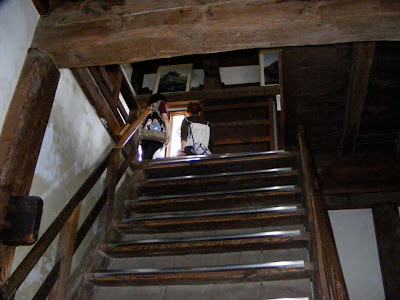
朝顔に
我は飯食ふ
男かな
asagao ni
ware wa meshi kû
otoko kana
Translations:
I am one
Who eats his breakfast,
Gazing at morning glories.
I am one
Eating my meal
While gazing at the glories of the morning.
Matsuo Bashô
Bashôs rebuke of Kikakus poem about tade and fireflies.
A firefly;
I partake of the smartweed
In my hermitage.
Kikaku (1660-1707)
The bridge to Shikoku was a truly awesome experience, hopping 14 kilometres across the ocean in a string of enormous bridges connecting small rocky islands. The transit went without hitch with Christine videoing while I drove and snapped stills as best I could.






















Shikoku is very different from Honshu in several respects. One respect noted in the Lonely Planet is the women, or particularly the women of the Southern city of Kochi, who are called 8-balls, because they are the nemesis doom of the men and strong-minded as a man with 8 balls, partly because they had to both protect their children and keep the family together in times of trouble when the men weren't around.
Our first stop was to the temples of Takamatsu.








Another unique feature of Shikoku, which becomes ever more remarkable as you make the transit, is that Shikoku is continuously circumnavigated by pilgrims, or Henro, of all sorts, following the 1400 km course of 88 temples on a journey of immediate enlightenment which has been ongoing for over 1000 years following the steps of the great Buddhist saint Kobo Daishi - kobo to spread the teachings widely and daishi saint - also in his lifetime called Kukai 'sky and sea'. Daishi founded the Shingon sect of Buddhism, the only major sect that believes enlightenment can be achieved in the current lifetime and the pilgrimage is a sadhana to achieve it. I see this very favourably as a basic credit rating of any religion to deliver on the realization agenda here and now. Many forms of Buddhism fail to do this and Christianity and Islam pass the whole agenda off to worshipping Christ or seeing the face of al-Llah in heaven which is a literal cop out.

Our experience of Henro began abruptly when we visited one of the 88 temples and immediately became caught up in a throng of elderly pilgrims who had erupted from a couple of buses to lead us to the temple tucked away up an alley where we had missed it. As we drive to a second temple, we passed several walking on foot wearing the characteristic while cloak, staff, bells, sash and conical hat, some pulling carts with their belongings. The next temple we tried to find, a pilgrim on foot jumped into the van and gave us emphatic instructions ordering us post haste to the major temple before closing time even paying for the car park to get us in in haste. Since then we have met pilgrims in cars, in taxis, on push bikes and following the Zen art of motorcycling on Kawasakis and even Harley Davidsons, but the most impressive are the countless number who steadfastly walk the journey on foot, straddling secluded forest paths and major highways including an 84 kilometre hike between the two most distant temples towards the wild southern Cape Muroto.






We then drove west to Marugame where there is a traditional castle in the centre of town and more temples.


























Zentsu-ji is where I wish to live, a holy place
never to fall into dust, ever lightened by the Buddha's vow.われ住まばよも消えはてじ善通寺 ふかき誓ひの法のともし火































0 件のコメント:
コメントを投稿